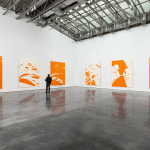
Contributed by Sharon Butler / Howard Smith’s understated paintings, on view at Jane Lombard Gallery, are created through a meticulous process of accumulation. Call the technique abstract pointillism. The surfaces are covered with small dots, dashes and brushstrokes, building loosely woven fields of color that sometimes form recognizable geometric shapes. The pieces in this show vary in size from one-inch to eight-feet wide, but the size of the marks remains the same. In most, the color at first glance appears monochromatic, but subtle variations within unified fields create illusions of light and shallow space. In his most recent paintings, the smallest flecks of color are innovatively contrasted with larger dots of different colors. Smith has spent years working in this way. It must be intensely hermetic and time-consuming, but it seems to have been rewarding.

In the early 1980s, Smith, who was born in Chicago in 1943, joined a group of like-minded artists known as the Radical Painting Group that included Raimund Girke, Marcia Hafif, Dale Henry, Anders Knutsson, Joseph Marioni, Carmen Gloria Morales, Olivier Mosset, Doug Sanderson, Erik Saxon, Phil Sims, Susanna Tanger, Frederic Matys Thursz, Gunter Umberg, Merrill Wagner, and Jerry Zeniuk. When painting seemed exhausted, the RPG tried to breathe new life into it by critically examining materials and process and forging reductive approaches. Smith, although not one of the founding members, was included in a 1986 exhibition at Williams College called “Radical Painting.” The work was abstract, self-referential, and often mistaken for monochromatic despite the subtle color differentiation. In “Beginning Again,” a 1978 Artforum essay about their new approach to painting, Marcia Hafif wrote: “Factors are set up, reasons for being, internal rules which are not imposed from the outside, but which function within a network of terms evolving from the work. Rules come into being through the process of thought and through the process of work, rules which are coherent within the terms of painting.”


This resolutely introverted approach was indeed radical in the early 1970s. Smith told me that he ultimately parted ways with RPG because they had become “too polemical.” If his work was rules-based at first, Smith has gone in a more improvisational, intuitive direction, richly evident in the work on view at Jane Lombard. He presents three distinct modes of painting that he calls Beginnings, Universes, and Families. The Beginnings are very small, hung salon-style from floor to ceiling. He has hundreds of these diminutive pieces and makes more every day. The Universes displayed on the adjacent wall are a little bigger than the Beginnings and usually have more complex compositions. The Families comprise work linked by approach rather than size, and may include larger pieces, hung here in a traditional side-by-side layout. The smaller ones are not studies, though they may suggest strategies that Smith later develops in bigger works.
Howard Smith is an exemplar of the conviction that painting isn’t about creating singular masterpieces but is rather a metaphor for life itself. For him painting is a lifelong process. Over decades he has developed a compelling visual language and produced a large body of work rooted in an idiosyncratic daily practice, focused on making one brushstroke at a time.
“Howard Smith: Marks in Time,” Jane Lombard Gallery, 58 White Street, Tribeca, New York, NY. Through March 5, 2022.
About the author: Sharon Butler is a painter and the publisher of Two Coats of Paint.























Hello
My name is Tj i live in Brighton uk.i have been trying to contact all who are involved with Howard Smith work.I have two textiles with very colourful birds on red green yellow black background, there old 24/24 frame size can you help in anyway to find out who the artist is or do i have Howard Smith work.Thank you i look forward to your email.